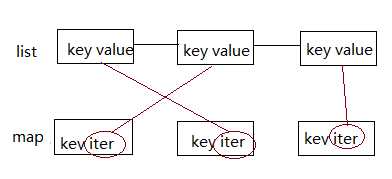标签:push code display 修改 oid second pre 支持 取数
运用你所掌握的数据结构,设计和实现一个 LRU (最近最少使用) 缓存机制。它应该支持以下操作: 获取数据 get 和 写入数据 put 。
获取数据 get(key) - 如果密钥 (key) 存在于缓存中,则获取密钥的值(总是正数),否则返回 -1。
写入数据 put(key, value) - 如果密钥不存在,则写入其数据值。当缓存容量达到上限时,它应该在写入新数据之前删除最近最少使用的数据值,从而为新的数据值留出空间。
进阶:
你是否可以在 O(1) 时间复杂度内完成这两种操作?
示例:
LRUCache cache = new LRUCache( 2 /* 缓存容量 */ ); cache.put(1, 1); cache.put(2, 2); cache.get(1); // 返回 1 cache.put(3, 3); // 该操作会使得密钥 2 作废 cache.get(2); // 返回 -1 (未找到) cache.put(4, 4); // 该操作会使得密钥 1 作废 cache.get(1); // 返回 -1 (未找到) cache.get(3); // 返回 3 cache.get(4); // 返回 4
list<pair<int,int>> 是一个双向链表,存储键值(key,value),map<int,list<pair<int,int>>::iterator>>是用来存放key值所对应的list中的位置

list链表的开头,是最近使用过的,当每次进行get()和put()操作时,我们就要更新。要注意的是,若(key1,value1)已经存在,当put(key1,value2)时,我们要直接修改value值,同时放到链表的开头。
list链表的末尾,是最久使用过的,当容量满时,就要将它替换出去,将最新的(key,value)放在链表开头
class LRUCache { private: int n; list<pair<int,int> > lis; unordered_map<int,list<pair<int,int>>::iterator> m; public: LRUCache(int capacity) { n = capacity; } int get(int key) { auto it = m.find(key); int ans = -1; if(it!=m.end()) { ans = it->second->second; lis.erase(it->second); lis.push_front(make_pair(key,ans)); it->second = lis.begin(); } return ans; } void put(int key, int value) { auto it = m.find(key); if(it!=m.end()) { lis.erase(it->second); lis.push_front(make_pair(key,value)); m[key] = lis.begin(); } else if(m.size()<n) { lis.push_front(make_pair(key,value)); m[key] = lis.begin(); } else { auto it = lis.end(); it--; m.erase(it->first); lis.erase(it); lis.push_front(make_pair(key,value)); it = lis.begin(); m[key] = it; } } }; /** * Your LRUCache object will be instantiated and called as such: * LRUCache obj = new LRUCache(capacity); * int param_1 = obj.get(key); * obj.put(key,value); */
标签:push code display 修改 oid second pre 支持 取数
原文地址:https://www.cnblogs.com/simplekinght/p/9573792.html